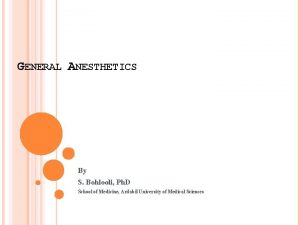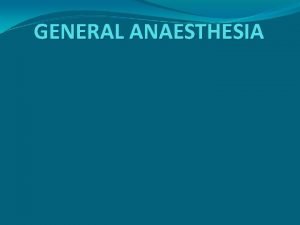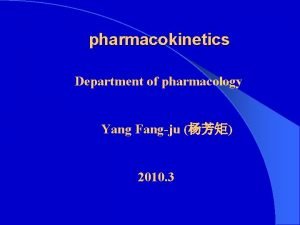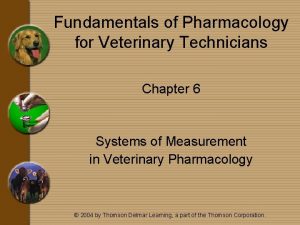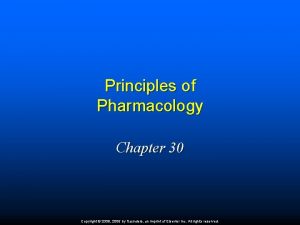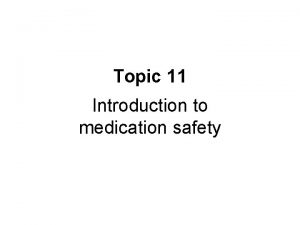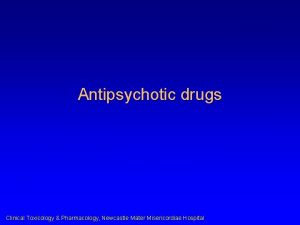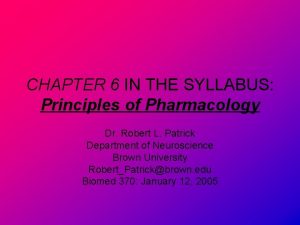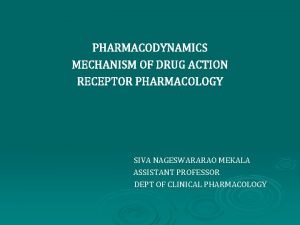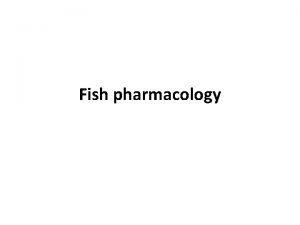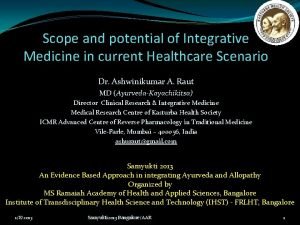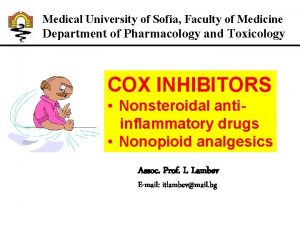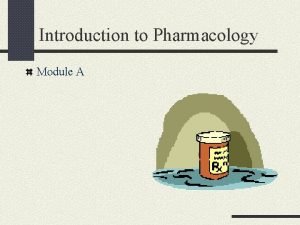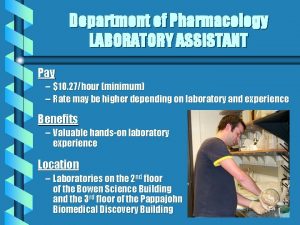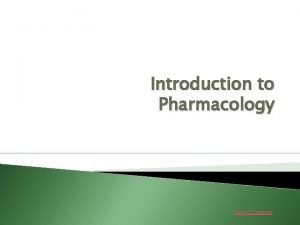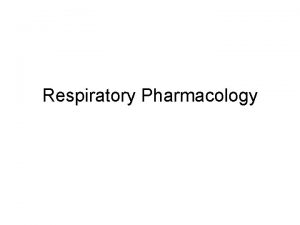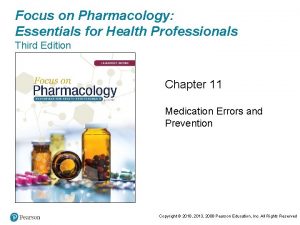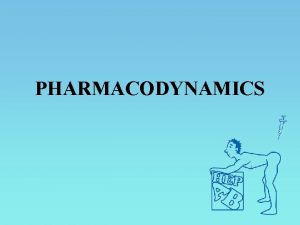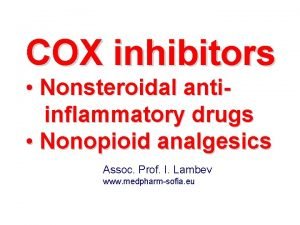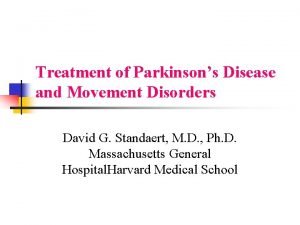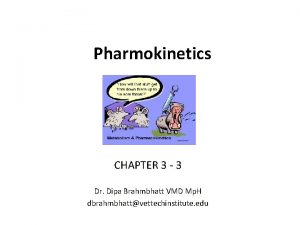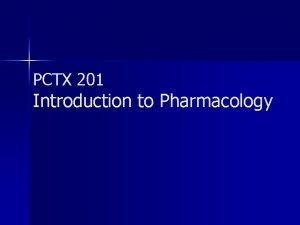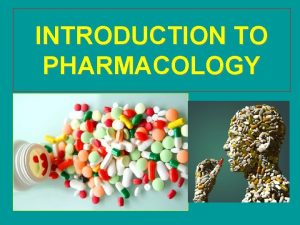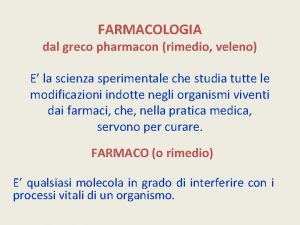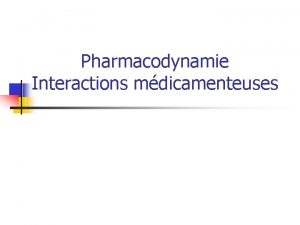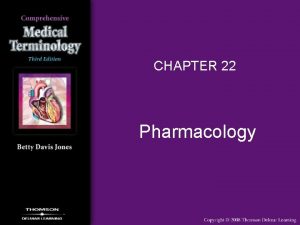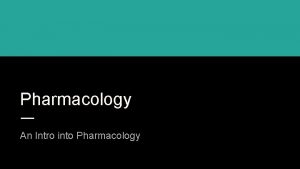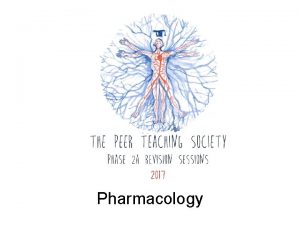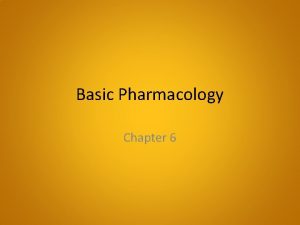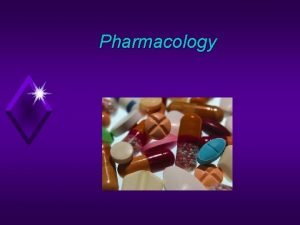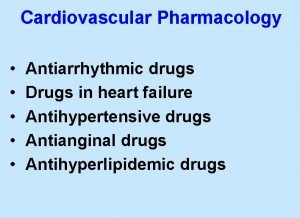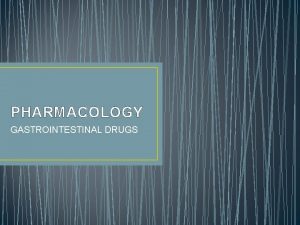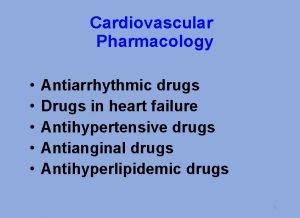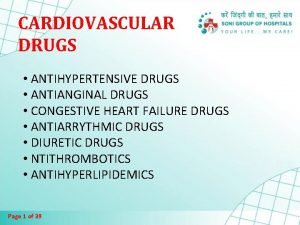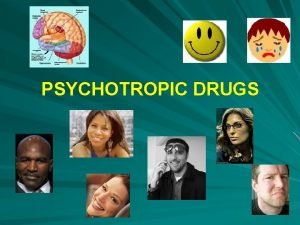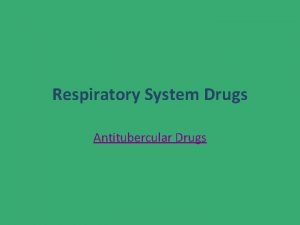General Pharmacology What is Pharmacology Pharmacology Pharmacon drugs



























- Slides: 27

General Pharmacology

What is Pharmacology? • Pharmacology: – Pharmacon (drugs) + Logos (studies) – The study of drugs 2

Drugs & Medicines • Drugs: – Any substance that, when absorbed into the body of a living organism, alters (changes) normal body function – Examples: • aspirin • Antibiotics • Nicotine • alcohol • Marijuana 3

Drugs & Medicines • Medicines: – In pharmacology, a drug is a chemical substance used in the: • treatment, cure, prevention, or diagnosis of disease • Or used to enhance physical or mental wellbeing 4

Drugs & Medicines • Drug is called medicine when used in proper dosage form for safe administration • All medicines are drugs but all drugs are not medicines 5

Clinical / Experimental • Clinical Pharmacology – deals with the study of drug effects in humans beings, i. e. healthy volunteers and patients • Experimental Pharmacology – deals with the study of drug effects in laboratory animals • In vitro – Isolated tissue • In vivo – Intact organism

Definitions • Toxicology: – deals with adverse (undesired) reactions of drugs & their treatment • Pharmacogenetics: – How genetics influence the mode of drug actions (e. g. . Metabolism) and biological variations of drug responses

• Pharmacogenetics is generally regarded as the study or clinical testing of genetic variation that gives rise to differing response to drugs. • Pharmacogenetics refers to genetic differences in metabolic pathways which can affect individual responses to drugs, both in terms of therapeutic effect as well as adverse effects. 8

• Pharmacokinetics: – How the body handles the drug – Includes absorption, distribution , biotransformation, and elimination • Pharmacodynamics: – How drug handles the body – Deals with the biochemical and physiological effects of drugs on man

• Tachyphylaxis : Rapidly developed tolerance is tachyphylaxis, is a medical term describing a decrease in the response to a drug due to previous exposure to that drug. • Caused by depletion or marked reduction of the amount of neurotransmitter responsible for creating the drug's effect, or by the depletion of receptors available for the drug or neurotransmitter to bind to. Examples: Amphetamine, ephedrine • Tachyphylaxis is characterized by the rate sensitivity i. e, a high-intensity prolonged stimulus or often-repeated stimulus may bring about a diminished response also known as desensitization. 10

• Physiological tolerance or drug tolerance is a subject's reaction to a drug (such as an opiates painkiller, benzodiazepine drug) is reduced at a later time even though the dose or concentration at the effect site is the same. • This means that larger doses are required to achieve the same effect. • Drug tolerance can involve both psychological & physiological drug tolerance factors. • It is reversible • Physiological tolerance occurs after repeated exposure. 11

• Idiosyncrasy (idiosyncratic drug reaction) denotes a non-immunological hypersensitivity to a substance, without connection to pharmacological toxicity. • Is an individual based on a specific condition of the one who suffers it. • Most commonly, this is caused by an enzymopathy, congenital or acquired. 12

Pregnancy Categories The FDA-assigned pregnancy categories as used in the Drug Formulary are as follows: Category A • Adequate and well-controlled studies have failed to demonstrate a risk to the fetus in the first trimester of pregnancy (and there is no evidence of risk in later trimesters). E. g. folic acid Category B • Animal reproduction studies have failed to demonstrate a risk to the fetus and there are no adequate and wellcontrolled studies in pregnant women. E. g. 13 2/11/2022 Acetamenophen

Category C • Animal reproduction studies have shown an adverse effect on the fetus and there are no adequate and well-controlled studies in humans, but potential benefits may warrant use of the drug in pregnant women despite potential risks. E. g. ciprofloxacin Category D • There is positive evidence of human fetal risk based on adverse reaction data from investigational or marketing experience or studies in humans, but potential benefits may warrant use of the drug in pregnant women despite potential risks. E. g. Phenytoin Category X • Studies in animals or humans have demonstrated fetal abnormalities and/or there is positive evidence of human fetal risk based on adverse reaction data from investigational or marketing experience, and the risks involved in use of the drug in pregnant women clearly outweigh potential benefits. E. g. thalidomide 14

FDA Pregnancy Categories FDA Category 15 Risk in Fetus Animals Humans A - Definitely No B No No studies available C Yes No studies available D - Evidence of risk Potential benefits may warrant use X Definitely Yes Definite fetal abnormalities 2/11/2022

Drug Regulations Drugs are strictly regulated in all countries. In Saudi Arabia, Saudi Food and Drug Authority regulates the sale and use of drugs. 16 2/11/2022

Controlled Substances and their Schedules These are the drugs that are known to have abuse potential. They can cause psychological dependence or addiction Schedule I (C-I) Drugs • High abuse potential and no accepted medical use (heroin, marijuana, LSD) Schedule II (C -II) Drugs • High abuse potential with severe dependence liability (narcotics, amphetamines, barbiturates) 17 2/11/2022

Controlled Substances and their Schedules Schedule III (C-III) drugs • Less abuse potential than schedule II drugs and moderate dependence liability (Acetaminophen/Codeine (Tylenol #3), acetaminophen/hydrocodone (Vicodin), propoxyphene) Schedule IV (C-IV) drugs • Less abuse potential than schedule III drug and limited dependence liability (diazepam (Valium), alprazolam (Xanax), phenobarbital, chloral hydrate) 18 2/11/2022

Controlled Substances and their Schedules Schedule V (C-V) drugs • Limited abuse potential. Primarily small amounts of narcotics (codeine) use as antitussive or anti-diarrheals. Some of them may be purchase as OTC drugs by above 18 individuals and sale should be recorded. • Prescribing physician and dispensing pharmacists of scheduled drugs must be registered and prescribed forms must be filled 19 2/11/2022

Drug Development and Evaluation It takes intensive research and long time to identify a chemical that might have therapeutic value. It must undergo a series of scientific tests to evaluate its therapeutic and toxic effects. These tests are strictly regulated and are known as Preclinical trials Phase 1 studies Phase 2 studies Phase 3 studies For every 100, 000 chemicals that are identified as potential drugs, only 5 reach the market 20 2/11/2022

Drug Development and Evaluation Preclinical Trials Drug are tested on laboratory animals for 1. To determine whether they have the presumed effects in living tissue 2. To evaluate adverse effects Drug is discarded if 1. It lacks therapeutic activity 2. It is too toxic 3. It is highly teratogenic to fetus 4. The safety margin is too small (therapeutic index) 2/11/2022 21

Drug Development and Evaluation Phase 1 studies If the drug passes preclinical trials, it is tested on humans because some drugs are therapeutic in animals but not in humans Healthy young male volunteers are selected for study. These studies are very tightly controlled and done only by specially trained clinical investigators. Women are not good because of risk to ovaries. 22 2/11/2022

The drugs are dropped if 1. They lacks therapeutic effect in humans 2. They causes unacceptable adverse effects • Some drugs move to next phase even if they fail because some other beneficial effect is observed in humans e. g. minoxidil was tested for malignant hypertension, but it had the adverse effect of hair growth. • However, because it was much more effective than other antihypertensives, that it was moved to phase 2 trials 23

Phase 2 studies If the drug passes phase 1 trial, it is tested on patients that have the disease the drug was intended for. Informed consent is obtained from patients and they are monitored very closely. The drug is dropped if 24 1. It is less effective than anticipated 2. It is too toxic and patients cannot tolerate it 3. The adverse effects are unacceptable 4. It has low benefit-to-risk ratio i. e. it is beneficial but has too many adverse effects 5. It is more expensive than other drugs in the market that are as effective 2/11/2022

Drug Development and Evaluation Phase 3 studies If the drug passes phase 2 trial, it is tested on a large number of patient, a thousand or more. Patients are asked to keep record of effects they experience after use of drug. Unexpected effects can come to notice at any stage. Post marketing surveillance Drug are kept under surveillance even after approval and marketing. Many drugs have been found to produce unacceptable adverse effects after many years of use e. g. Vioxx (Rofecoxib) and thalidomide 25 2/11/2022

QUESTIONS? 26

THANK YOU 27
 Pharmacology of drugs acting on respiratory system
Pharmacology of drugs acting on respiratory system Adrenal drugs pharmacology
Adrenal drugs pharmacology General anesthesia drugs dosage
General anesthesia drugs dosage General anesthesia drugs
General anesthesia drugs Classification of inhalational agents
Classification of inhalational agents Diferencia entre gran plano general y plano general
Diferencia entre gran plano general y plano general Where did general lee surrender to general grant?
Where did general lee surrender to general grant? Bioavailability
Bioavailability Pharmacology for veterinary technicians
Pharmacology for veterinary technicians Chapter 30 principles of pharmacology
Chapter 30 principles of pharmacology Rationale meaning in pharmacology
Rationale meaning in pharmacology Pharmacology newcastle
Pharmacology newcastle What is pharmacology
What is pharmacology Receptors in pharmacology
Receptors in pharmacology Fish pharmacology
Fish pharmacology Reverse pharmacology
Reverse pharmacology Basic & clinical pharmacology
Basic & clinical pharmacology Pharmacology module
Pharmacology module What is ion trapping in pharmacology
What is ion trapping in pharmacology Pharmacology pay
Pharmacology pay Pharmacology introduction
Pharmacology introduction Mdi pharmacology
Mdi pharmacology Focus on pharmacology essentials for health professionals
Focus on pharmacology essentials for health professionals Tachyphylaxis in pharmacology
Tachyphylaxis in pharmacology Analglesia
Analglesia Dopamine pharmacology
Dopamine pharmacology Ion trapping
Ion trapping Pharmacology chapter 1
Pharmacology chapter 1


